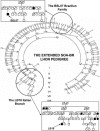Haplogroup effects and recombination of mitochondrial DNA: novel clues from the analysis of Leber hereditary optic neuropathy pedigrees
- PMID: 16532388
- PMCID: PMC1424694
- DOI: 10.1086/501236
Haplogroup effects and recombination of mitochondrial DNA: novel clues from the analysis of Leber hereditary optic neuropathy pedigrees
Abstract
The mitochondrial DNA (mtDNA) of 87 index cases with Leber hereditary optic neuropathy (LHON) sequentially diagnosed in Italy, including an extremely large Brazilian family of Italian maternal ancestry, was evaluated in detail. Only seven pairs and three triplets of identical haplotypes were observed, attesting that the large majority of the LHON mutations were due to independent mutational events. Assignment of the mutational events into haplogroups confirmed that J1 and J2 play a role in LHON expression but narrowed the association to the subclades J1c and J2b, thus suggesting that two specific combinations of amino acid changes in the cytochrome b are the cause of the mtDNA background effect and that this may occur at the level of the supercomplex formed by respiratory-chain complexes I and III. The families with identical haplotypes were genealogically reinvestigated, which led to the reconnection into extended pedigrees of three pairs of families, including the Brazilian family with its Italian counterpart. The sequencing of entire mtDNA samples from the reconnected families confirmed the genealogical reconstruction but showed that the Brazilian family was heteroplasmic at two control-region positions. The survey of the two sites in 12 of the Brazilian subjects revealed triplasmy in most cases, but there was no evidence of the tetraplasmy that would be expected in the case of mtDNA recombination.
Figures



References
Web Resources
-
- GenBank, http://www.ncbi.nlm.nih.gov/Genbank/ (for the complete mtDNA sequences [accession numbers DQ341083–DQ341090])
-
- Online Mendelian Inheritance in Man (OMIM), http://www.ncbi.nlm.nih.gov/Omim/ (for LHON) - PubMed
References
-
- Achilli A, Rengo C, Magri C, Battaglia V, Olivieri A, Scozzari R, Cruciani F, Zeviani M, Briem E, Carelli V, Moral P, Dugoujon J-M, Roostalu U, Loogväli E-L, Kivisild T, Bandelt H-J, Richards M, Villems R, Santachiara-Benerecetti AS, Semino O, Torroni A (2004) The molecular dissection of mtDNA haplogroup H confirms that the Franco-Cantabrian glacial refuge was a major source for the European gene pool. Am J Hum Genet 75:910–918 - PMC - PubMed
Publication types
MeSH terms
Substances
Associated data
- Actions
- Actions
- Actions
- Actions
- Actions
- Actions
- Actions
- Actions
Grants and funding
LinkOut - more resources
Full Text Sources

